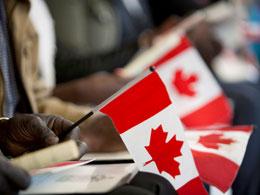Canada to stabilize immigration levels

By Mata Press Service
In response to the strain on housing and public services, the Canadian government has made plans to stabilize the intake of new permanent residents by 2026, Immigration Minister Marc Miller has announced.
Minister Miller presented the immigration objectives for the forthcoming three years, proposing to maintain the number of new permanent residents at a constant figure of 500,000 for the year 2026.
According to the proposed agenda, there will be a gradual increase in the targets for 2024 and 2025, with figures reaching 485,000 and 500,000 respectively.
Over the past few years, the Liberal government has markedly escalated its immigration targets, setting new records for the admission of permanent residents in both 2021 and 2022.
This policy of increased immigration has been subject to critical examination due to the challenges posed by a national housing shortage and the demand for more affordable housing options.
Minister Miller acknowledged the dual nature of the situation, highlighting the vital role immigrants play in bolstering Canada’s economic development and workforce, while also recognizing the need to manage their effect on the nation's infrastructure, including housing.
He addressed these nuanced points at a news conference on Parliament Hill this week, asserting, “These immigration levels are designed to contribute to Canada’s economic and demographic expansion, while also tempering the pressure on essential services like infrastructure and housing.”
The Royal Bank of Canada said while the pause in targeted immigration levels was appropriate given housing challenges and eroding public support, Canada would need immigrants in the long term.
The annual immigrant intake of 1.3% of the population was not sufficient to stabilize the age structure of the population, which would require immigration of about 2.1%, the country's top lender said in a report.
Canada's population has grown mainly through immigration, and population growth has helped fuel economic growth in recent years.
Some economists have blamed immigration for worsening the country's housing shortage, even though some immigrants also work in industries like construction that are facing a labour shortage.
For this reason, the Bank of Canada has said immigration has been both a driver and a brake for inflation, which stood at 3.8% in September.
More consumers mean more demand, which pushes up prices, but immigrants entering the workforce also help keep down labour costs.
A strong inflow of immigrants helped Canada's population to grow last year at its fastest pace since 1957, placing it among the top 20 fastest-growing countries in the world, Statistics Canada said, in part offsetting the effects of aging residents who are retiring and adding to healthcare costs.
An increasing number of newcomers to Canada have in recent years opted to leave, posing a challenge to a country heavily dependent on immigration for population and economic expansion, the Institute for Canadian Citizenship said earlier this week.
Highlights of the 2024-2026 Immigration Levels Plan include:
- A continued long-term focus on economic growth, with over 60% of permanent resident admissions dedicated to the economic class by 2025.
- A commitment to uphold the Government of Canada’s humanitarian tradition support effort by responding to humanitarian and geopolitical crises around the world.
- New ambitious Francophone immigration targets to support Francophone communities outside of Quebec. The targets represent 6% of total immigration in 2024, 7% in 2025, and 8% in 2026. This is to strengthen Francophone communities outside of Quebec and ensure the economic prosperity of Francophone minority communities across Canada.
Meanwhile, a new study said there was a “record spike” in the number of immigrants who left Canada between 2016 and 2019.
On average, 0.9 per cent of people who were granted permanent residence in or after 1982 left Canada each year, according to the study conducted by the Institute for Canadian Citizenship (ICC) and the Conference Board of Canada.
“We are now seeing people who are coming to Canada and then saying, ‘Ah, no thanks,’ and moving on,” Daniel Bernhard, ICC’s chief executive, said. “And the number of those people are increasing.
“We have to believe that the lack of availability of housing, of health care, of other types of services are part of it.”
The study included people who were granted permanent residence between 1982 and 2018 and those who filed taxes in Canada at least once after landing.
According to CIC news, Quebec also tabled its immigration levels plan for 2024 and 2025 this week.
Quebec is the only province in Canada that can shape its annual permanent resident admissions targets. This is due to their special status in Canada. Quebec has the authority to shape its immigration targets to help preserve its distinct francophone character. Today, the province announced it will look to welcome 50,000 new immigrants in 2024, and another 50,000 immigrants in 2025. – with Agencies
Quick Facts
1. Immigrants are essential to the future of the Canadian economy.
2. In 2022, 105,235 individuals transitioned from temporary to permanent residents.
3. The 2024-2026 Immigration Levels Plan aims to welcome 485,000 permanent residents
4. The plan is focused on spreading the benefits of immigration to regions and communities across Canada.
5. By 2025, overall admissions will amount to nearly 1.3% of the Canadian population with 60%+ of admissions in the economic class.
6. Working to increase Francophone immigration to reach a target of 6% of French-speaking immigrants outside Quebec by 2024.
7. Employers in communities across Canada will be supported to fill their critical labour needs.









